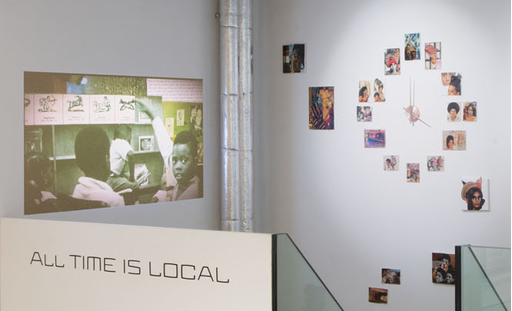
Author(s)
Amiri Baraka
“Rhythm Travel” (1995) was published in Amiri Baraka’s short story collection, Tales of the Out & the Gone (Brooklyn: Akashic Books, 2007), republished here with kind permission of Akashic Books.

But then at once, music comes on. If you watching, there’s a bluish shaking that flickers—maybe “Misterioso” will surround you. The music is wavering like light. The room seems to shift, to step.
Then you recognize what you hear, man. “Aw, brother, you at it again. You in here, ain’t you?”
A laugh. This dude.
“Yeh, I’m in here. You hear me. You feel me. Here I am.” He appears, laughing and pointing at you. “Hey, man. I’m still developing this.”
“What you call it?”
“Anyscape. The 1st one. Molecular Anyscape. The Resoulocator—that was the improvement. T-Dis-Appear. Nicknames. Perfect Nigger. American Citizen. Ellisonic. Migration. I got a name for each step.”
“And now?” I rolled my eyes as he got completely out next to me, dissing the Dis report on Appearance.
“This is the next to last. I can disappear. Dis visibility, be unseen. But now I can be around anyway, perceived, felt, heard. I can be the music! Yeh. But now I got something even heavier.”
This dude is out—it ain’t no jive. He had actually done those things. And he never swore me to secrecy either. He just fixed it so I couldn’t remember nothing, except when I came back.
“Further out? The cloth refiner?” He said he needed to make the cloth fade more so he could get in and out of the bank w/o any hysteria. It took a few hundred thousand to get where he was technically.
“How come they don’t detect the money splitting?”
“Well, I ain’t been able to stabilize the cloth thing. Sometimes people see the money floating off. But I still get away.”
“How come they don’t say nothin’?”
“Well, it’s hard to explain, I guess. Floating money. They studying it.”
“Oh?”
“A few weeks more, I’ll rob all the mammy-jammas clean!”
“Wow!” I thought of a stream of exclamations, but I could only analyze it while hearing it. I needed to reflect, but your boy wouldn’t allow it.
“But now, B., dig this! I pushed the Anyscape into Rhythm Spectroscopic Transformation. And then I got it tuned to combine the Anywhereness and the Reappearance as music!”
“What? Brother, you know this is some deep technical stuff.”
“Aw, no it ain’t. It’s science. I can teach people how to make and use these. ”
“What?”
“Now I added Rhythm Travel! You can disappear & reappear wherever and whenever that music played.”
“What?”
“So if you become “Black, Brown & Beige,” you can reappear anywhere and anytime that plays.”
“Go anywhere?”
“Yeh, like if I go into ‘Take this Hammer,’ I can appear wherever that is, was, and will be sung.”
“Yeh, but be that song and you be on a plantation.”
“I know.” He was grinning. “I went to one.” He was staring me down, winking without his eye. “I seen some brothers and sisters digging a well. They were singing this and I begin to echo. A big hollow echo, a sorta blue shattering echo. The Bloods got to smilin because it made them feel good, and that’s the way they heard it anyway. But the overseers and plantation masters winced at that. They’d turn their heads sharply back and forth, looking behind them and at the slaves. Man, the stuff I seen!”
“You mean you been Rhythm Traveling already?”
“Yeh, I turned into some Sun Ra and hung out inside gravity. You probably heard of the Scatting Comet. Babs was into that.”
“Really? Man, so—”
“I know. Why? What I’m gonna do with it? Yeh, but I’m just explaining now. I got a lotta tests.”
“I guess so.”
“But I want you to try it.”
“Hey …”
“Hey, brother. Ain’t no danger. Just don’t pick a corny tune.”
Related

“Rhythm Travel” (1995) was published in Amiri Baraka’s short story collection, Tales of the Out & the Gone (Brooklyn: Akashic Books, 2007), republished here with kind permission of Akashic Books.

Temporal drag, erotohistoriography, chronomornativity, horniness under capitalism, rhythm, dancing, and crip time.

Black Quantum Futurism (Camae Ayewa and Rasheedah Phillips) in conversation with Jeanne van Heeswijk and Rachael Rakes.

“The Clearing: Music, Dysfluency, Blackness, and Time” was originally published in Journal of Interdisciplinary Voice Studies, 5, no. 2, 2020, pp. 215–233 and is republished here in revised form with kind permission of the author.

When Indigenous communities are asked to provide proof of their connection to ancestral lands, what Western legal forums accept as documentation does not truly represent or respect tribal culture and traditional formats of knowledge transfer.

How do we reckon with our attachments to place, and their knotted historical relations? A meditation on maritime trade routes, SEA – SHIPPING – SUN (2021), is a short film directed by Tiffany Sia and Yuri Pattison shot over the span of 2 years to render a simulated duration of a day, from The film is set against a soundtrack of shipping forecasts from archival BBC Radio 4 broadcasts. The sun emerges and disappears, again and again.dawn until dusk.

In this essay, Amelia Groom responds to Tehching Hsieh’s One Year Performance 1980–1981: Time Clock Piece (1980–1981), one of the works on view as part of the No Linear Fucking Time exhibition at BAK, basis voor actuele kunst, Utrecht. Through a reading of Dolly Parton’s contemporaneous antiwork anthem 9 to 5 (1980), Groom reflects on historical shifts in the ways that workers have been and continue to be exploited through techniques and technologies of time.

Grappling with the imposed linearity of timespace as a fundamental feature of colonial violence, this essay by Promona Sengupta (also known as Captian Pro of the interspecies intergalactic FLINTAQ+ crew of the Spaceship Beben) proposes a mode of time travel that is “untethered from colonial imaginations of the traversability of time and space.”

Weird Times (2021), is a 30-page chapbook by artists Tiffany Sia and Yuri Pattison on time-telling and hegemony. Featuring writing by Sia and images selected by Pattison, it is a brief history of the development of time-keeping technologies. The clock is disassembled as a political tool, a metronome of coercion and an accelerant of war power. Out of these mechanisms, resistant counter-tempos emerge.

An online conversation with performance artist Tehching Hsieh, writer Amelia Groom, and writer and curator Adrian Heathfield, moderated by BAK curator of public practice Rachael Rakes on 20 January 2022. The conversation takes Hsieh’s work as a starting point in addressing performative time, labor time, gaps, and rhythms of endurance, among other things.

The “No Linear Fucking Time Bibliography” is an evolving resource which compiles selected scholarly and artistic texts relating to the various strands of study involved in this project.

In “Reclaiming Time: On Blackness and Landscape” (first published in PN Review 257 in 2021), poet Jason Allen-Paisant traces the racialized social contexts and modern environmental constructs that “disproportionately rob Black lives of the benefits of time.”

While walking through the “Nothing To Declare” arrivals gate at London Stansted Airport, Sam Keogh is confronted by three border guards: a pig, a unicorn, and a worried cartoon clock.

In this conversation with Walidah Imarisha (first published in Toward the Not Yet: Art as Public Practice, published by BAK and MIT Press, 2021), the writer and activist outlines her concept of “visionary fiction” as an imaginative practice to emancipate futures from the stronghold of linear time.

Drawing from her work as part of the Karrabing Film Collective, Elizabeth A. Povinelli’s essay “In Some Places the Not-Yet Has Long Been Already” (which first appeared in Toward the Not Yet: Art as Public Practice, published by BAK and MIT Press, 2021) contrasts the temporal orientation of late settler liberalism—which is troubled by the coming catastrophes of climate collapse—with the ancestral catastrophes of coloniality and enslavement, which are both past and present.

Designed by Rissa Hochberger, with additional design by JJJJJerome Ellis and Kelvin Ellis, the book The Clearing is the eighth title in Wendy’s Subway’s Document Series, an interdisciplinary publishing initiative highlighting the work of time-based artists in printed form.

In her text “Dearest Zen (Letters to Lichen),” artist and scientist Adriana Knouf presents future love letters written to lichens, symbiotic organisms of fungi and algae or cyanobacteria.

In “Immortals: On the Ancient Future Lives of Stone and Plastic,” Marianne Shaneen blends stories, histories, and ontologies of two substances: stone and plastic.

“The Clearing: Melismatic Palimpsest” is a part of musician and writer JJJJJerome Ellis’s multi-faceted project The Clearing (book published by Wendy’s Subway and album of the same name released by NNA Tapes, 2021). Conceiving of the forest and its clearings as “sites of resistant black oralities for centuries,” Ellis explores how stuttering, blackness, and music can figure within practices of refusal against the hegemonic governance of time, speech, and encounter.